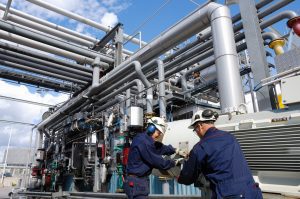The World Economic Forum in January 2017 highlighted that digitization in the mining industry has the potential to deliver over $425 billion in shareholder, customer and environmental value by 2025. Much of this value will come in the form of optimized operational effectiveness, increased productivity, and enhanced safety.
However, with increased opportunity comes inherent uncertainty, and Ernst & Young has identified digital effectiveness as the top risk currently facing the mining and metals sector. Realizing the value of digitization requires strategic planning, strong industrial partnerships, realignment of culture, and appropriate selection and deployment of digitization technologies.
Most mining companies are either actively engaged or in the process of evaluating how best to optimize their operations by leveraging digitization to drive efficiencies and remain competitive. Many however have yet to travel very far down the digitization path and are uncertain on where to start or how to connect seemingly disconnected initiatives into a single cohesive digital transformation strategy. Key digitization decisions will center around which technologies to adopt and the best way to accelerate the path to digitization-related business benefits.
Being proactive in seeking and activating a clear digital path is critical to unlocking value. Now is not the time to take a back seat. Assessing current processes, identifying areas that represent opportunities for “quick wins,” and identifying projects that represent a low-cost/ short-time implementation that can generate a rapid return on investment are key. There is no need to go it alone, especially initially as there are capable, knowledgeable, experienced and digitally-savvy partners available. The importance of the first initial success however should not be underestimated as it is necessary to develop both acceptance of the untapped value available as well as support for further and larger initiatives.
Identifying an effective starting point
Schneider Electric has been at the forefront of many digitization efforts across the mining sector globally, either with complete EcoStruxure™ solutions or deployed systems across multiple IOT platforms. We can do this because of our well-established and recognized approach to open architectures across connected products, edge and application domains. This allows data to be collected from any connected device while also eliminating restrictions to any future evolution of your digital platform.
At Schneider Electric, 5% of our annual revenue is invested directly into R&D projects, an increasing portion of which is related to digitization. The global knowledge gathered by companies like Schneider can be passed along in the form of digitization implementation strategies and best-practices across many mining application areas.
Four areas of significant opportunity
For mining companies starting on this journey, four environments in particular merit close scrutiny as potential areas where digitization deployments can result in quick wins:
- Safety transcends every aspect of mining, and the traditional process of maintaining safety instrumented systems in a potentially dangerous environment usually represents a high, but necessary cost. Integrated, digital solutions are available that can help improve your overall safety performance.As an example, arc flash generates temperatures of up to 19,000°C /35,000°F and hence procedures for accessing electrical facilities is strictly controlled and the training for technicians and artisans is extensive. Research from the University of Colorado has shown that simulated operator training utilizing virtual reality can provide a 9% higher retention rate than traditional learning processes.
- Operational Excellence Solutions optimize and stabilize process performance and reduce energy usage, thereby achieving the highest level of performance and reliability from critical assets. In mining operations, various forms of equipment such as drill rigs, excavators and haulage trucks (commonly referred to as the mobile fleet) represent a sizable chunk of both capital and operational costs. A single haul truck can have more than 300 sensors collecting and pushing data each millisecond on its location, condition, and performance.One small example of utilizing digital data to optimize operational excellence and reduce costs is where Schneider Electric recently implemented our Fuel Management System utilizing existing data generated at a mine site to help address concerns with fuel loss. The data was used to accurately map and visualize the use of fuel across the mine site by storage facility and mobile asset. It generated savings of over 100,000 gallons (10%) which previously had been unaccounted for. Unlike most other fuel systems, our system is based on industrial grade telemetry that keeps data safe and secure even through a power outage. It is also an open solution enabling integration with other systems.
- Digital Supply Chain Solutions integrate activities from resource to market, including inventory management and operations and planning.An example here involved a major iron ore producer who utilized Schneider Electric’s sophisticated Advanced Planning & Scheduling (APS) modeling approach to help predict how each entity in the supply chain would operate from mine, plant, rail and port – not as discrete components, but as a single system that operated with unified objectives and associated KPIs. Post implementation supply chain efficiencies increased by up to 20%.
- Next Generation Workforce Technologies attract and empower the next generation of workers and facilitate knowledge transfer, collaboration, situational awareness and safety, mobility and remote operations.A good example includes augmented reality, an innovative app for mobile devices that uses the device’s camera to recognize electrical panels, cabinets, machines and process areas and then superimposes real-time data and virtual objects onto them. This gives operators and technicians immediate access to relevant technical, performance and condition information and speeds up decision-making, troubleshooting, and performance efficiency.
Digitalization is a cultural issue as much as it is a technology issue, and any viable digitalization strategy should seriously consider the human aspect of how digitalization will impact workers and employees. The hearts and minds of employees are only won when the proposed changes are understood and are accepted as beneficial and non-threatening to the employees’ current role or livelihood. Job specific information must be easy to access and interpret. In truth, some traditional roles will require realignment, but the new technologies will also create multiple new roles and opportunities within organizations. Automation and digitalization cannot survive without a human interface at this stage.
To learn more about how digitalization solutions can help you reduce your mining operations costs, enroll in our on-demand webinar entitled, the Digital Mining Transformation.
Or browse some of these recent articles on the subject I have found to be very informative:

